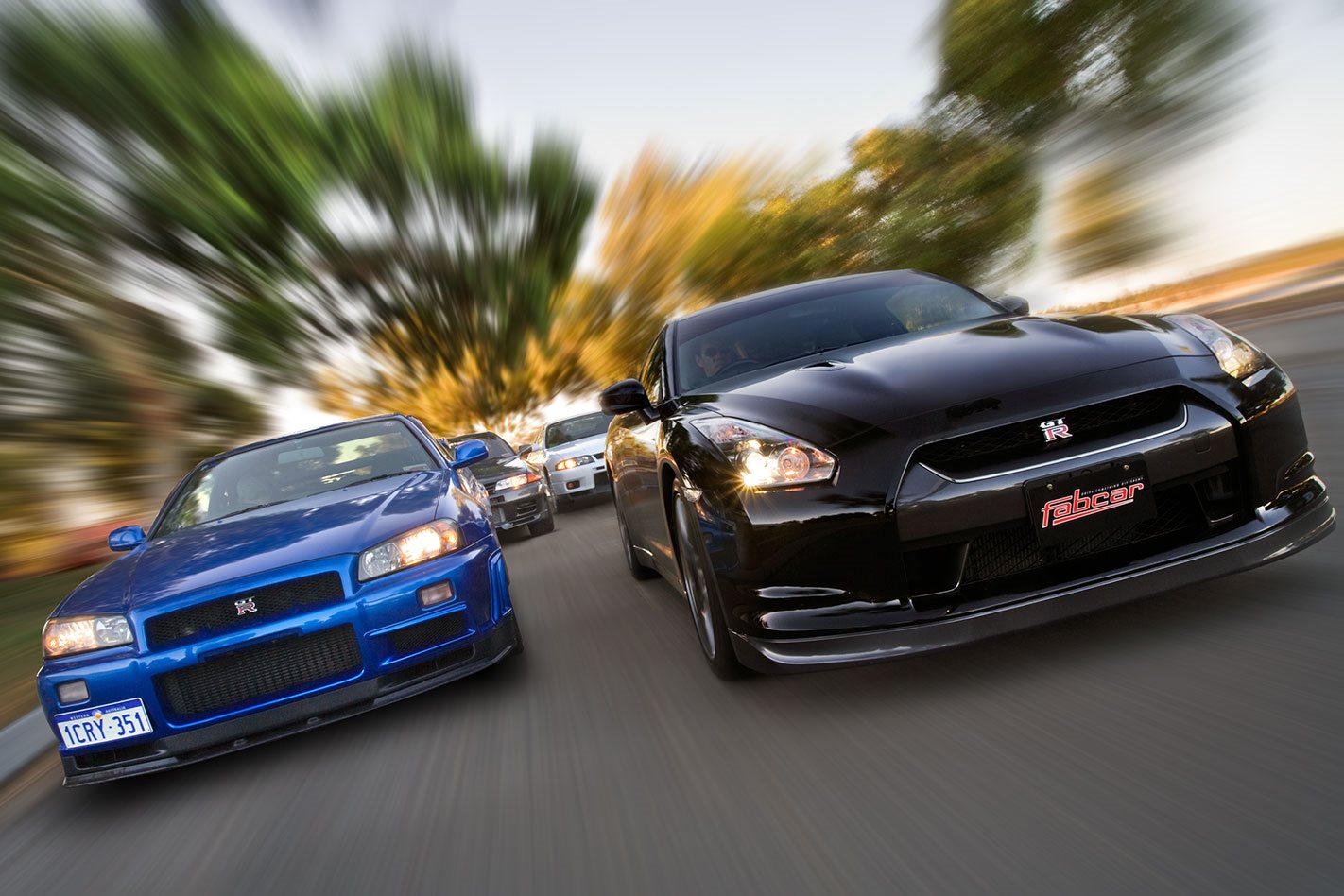The GT-R legend has now reached demi-god status. And you can pretty much thank its third generation – the turbocharged and all-wheel-drive and R32, R33 and R34 series released between 1989 and 2002 – for all of the kudos.
This feature was first published in MOTOR magazine’s May 2008 issue.
The R32, the original Godzilla, created and engineered for a hugely and successfully dominant Group A touring car campaign, set the legend rolling. But the entire last generation – with its Skyline DNA and singularly devoted and potent combination of twin-turbocharged straight-six power and bleeding-edge all-wheel-drive technology – propelled the GT-R enigma into the stratosphere. Well before the reinvented R35 figured on the horizon, the halo around the GT-R brand had become thermonuclear bomb-proof.
For two decades, raves and plaudits flowed for the third-generation stuff from those who’d driven them. Few have doubted the GT-R’s prowess, but as the old breed sold almost exclusively in Japan new – bar the 100 that slipped into Aussie new-car obscurity in 1991 – very few petrolheads ever had a chance to form an unbiased appraisal of these cars.

By nature of its existence, the GT-R has remained pretty much elusive to real-world critique and the everyday, everyman driving experience.
Instead, the measure of GT-R’s prowess has been gauged largely by its initial on-track successes and, later, by its often outrageous yet eye-opening potential derived through aftermarket fettling.
Much of the fuel for the legend’s fire has come from hype, fanned along by starry-eyed enthusiast owners and brand loyalists largely involved with second-hand grey/private import examples, mystical modified horsepower figures and claimed Nordschleife lap times. Where’s the truth when, as is now widely accepted, Nissan Japan fudged something as cut-and-dried as the GT-R’s output figures.
The GT-R legend is unique, and has been allowed to grow and prosper to a level almost beyond reproach. That is, until a GT-R successor arrives. In other words, until now.
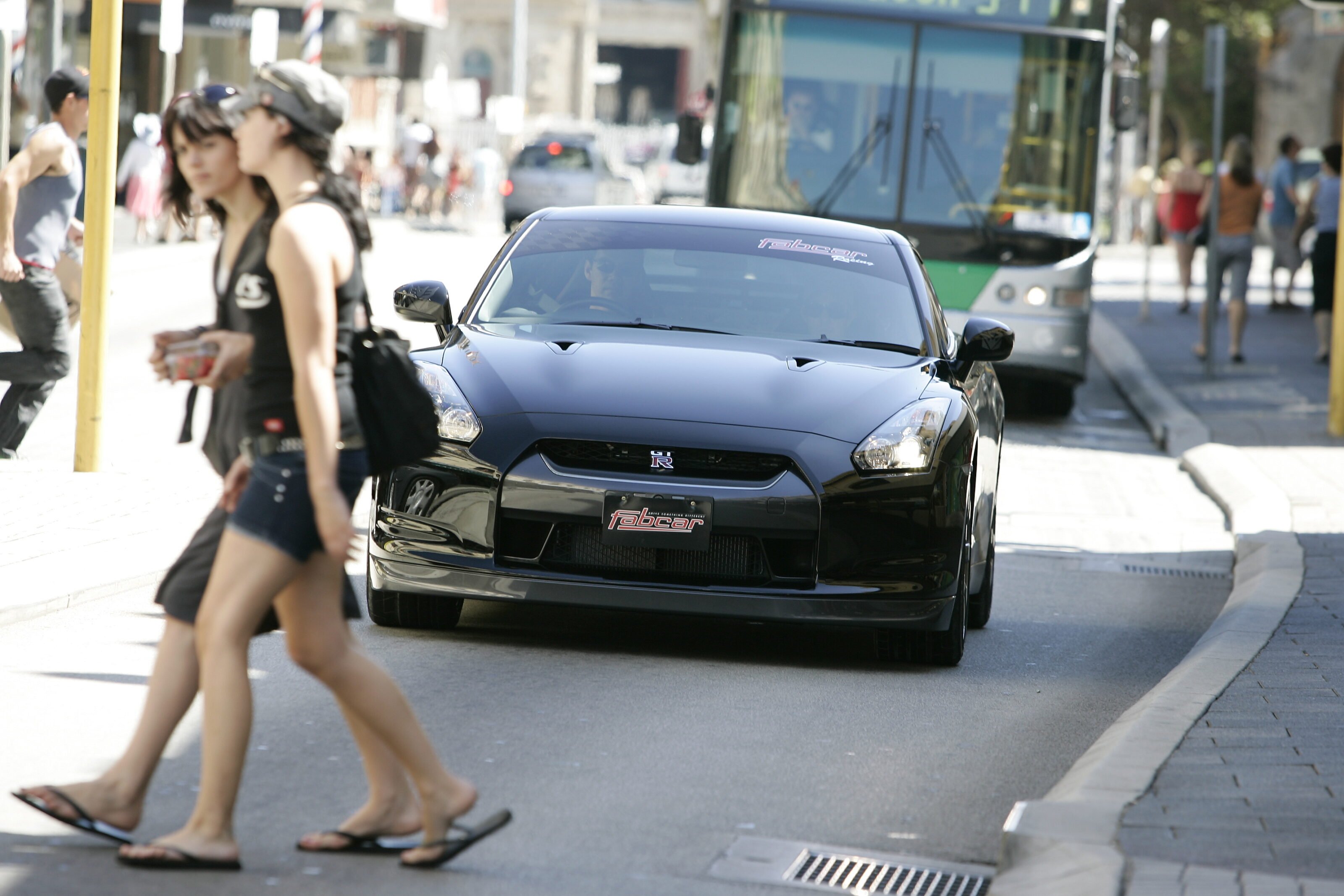
So it’s game on. In what is, to our knowledge, a world exclusive, we’ve pitted the new and completely reinvented R35 GT-R against its third-generation Skyline-based forefathers.
Of course, you can’t expect to compare two decades of motoring history and expect a photo finish. And some die-hard GT-R fans may cry foul. But how else could you measure the hyper-anticipated new boy against The GT-R Legend? And as the original R32 is still widely considered the benchmark, even now, how do its successors rank against the originator?
No one was brave enough to pick the outcome. But no one in the crew, or the extremely generous and accommodating guys from Perth’s Fabcar who supplied our Godzilla fleet, expected the bombshell result that came once the dust settled.
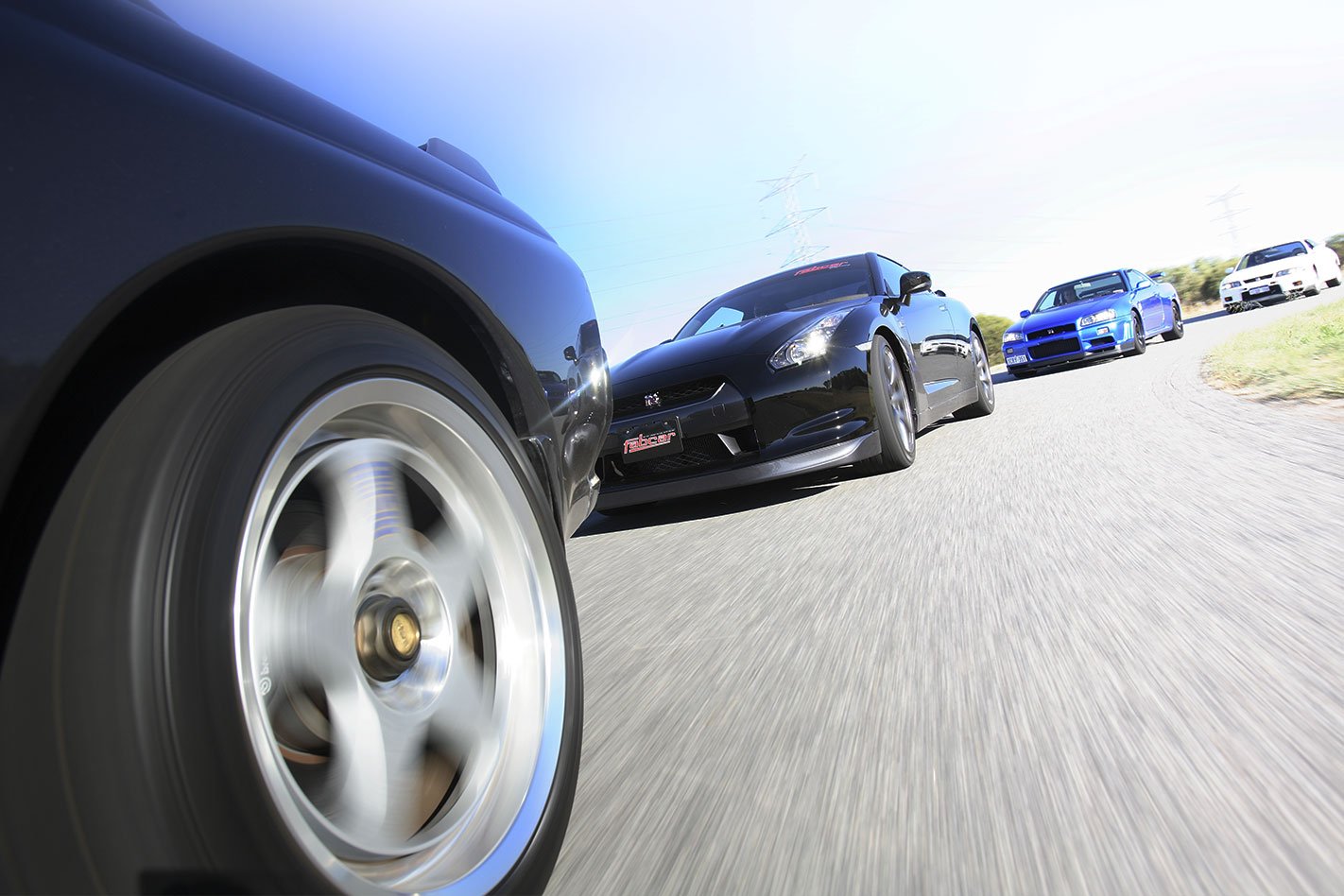
All models were put through subjective driving impressions by two judges (Dupriez and Pearce). For objectivity, all cars were sent for two timed fliers around a test course at Perth’s SpeedDome in Midvale, which is commonly used for WA sprint events. (We’ve published the quickest time for each car.)
Our test cars varied in age (obviously) and accumulated mileage. But for the purposes of accuracy, we opted for the cleanest and least-modified examples of the older stuff that was available. Bar specifically listed enhancements mentioned in each review, these cars are completely standard.
The Test Track
It ain’t the Nordschleife. Or Mount Panorama. But SpeedDome, a popular venue in Midvale, Perth used for local sprint and targa events, was selected for pitting two decades of Nissan heroes against each other.
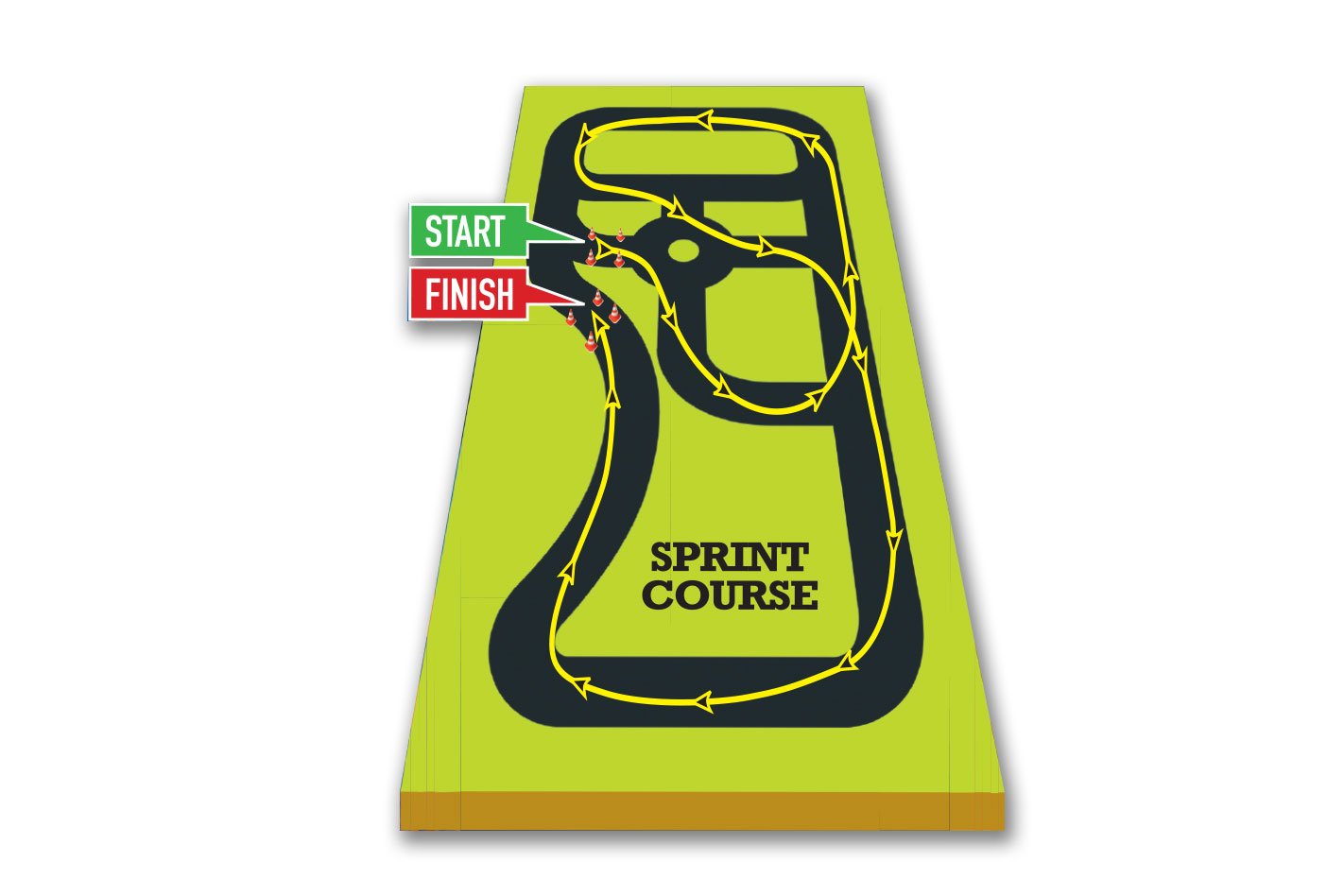
A tight course would also reveal whether R35’s weight is a genuine handicap or not, and give some of the older GT-Rs a genuine chance to shine without them enduring the mechanical punishment a full-sized circuit dishes out on brakes and tyres.
Six Appeal
The original third-gen GT-R, the R32, (1989-1994) was initially intended to have a 2350cc engine capacity to compete in under 4000cc racing class, as under the era’s FIA Group A touring car rules, turbo cars had their capacity multiplied by 1.7 for classification. However, once the added weight of the all-wheel-drive system was factored in, it was decided to increase capacity to 2568cc, lifting the GT-R into the 4500cc racing class which allowed fitment of huge 11-inch-wide racing tyres.
The RB26DETT quickly gained a reputation as the benchmark engine of Japan’s 90s turbo era. In road-going form, using meagre parallel-style low-mounted twin turbochargers for brisk boost response, it offered exceptional mid-range and a heady top-end delivery for its modest 2.6-litre capacity. But, engineering-wise, the straight six was bred for motorsport. And in race form (approx 400kW), or when modified (700kW-plus), it’s lofty output and outright potential almost defied belief.
The RB26’s short-stroke design allowed engine speeds exceeding 8000rpm, even in standard trim. The iron block was sturdier than most production rivals (followed later by thicker-cast enduro-spec N1 blocks).
Up top, the alloy-head and valvetrain design were race-bred, with six individual throttle bodies fed charged air from a large, front-mounted intercooler. All cutting-edge stuff for ’80s tech.
Nissan’s claim of 280PS (206kW) for all road-going RB26DETTs has long been considered, er, conservative.
Size Matters
| u00a0 | R32 | R33 | R34 | R35 |
| Length | 4545mm | 4675mm | 4600mm | 4655mm |
| Width | 1755mm | 1780mm | 1785mm | 1895mm |
| Wheelbase | 2615mm | 2720mm | 2665mm | 2780mm |
| Front Track | 1480mm | 1480mm | 1480mm | 1590mm |
| Rear Track | 1480mm | 1490mm | 1490mm | 1600mm |
| Weight | 1430kg | 1530kg | 1540kg | 1750kg |
| kW/Tonne | 144kW | 135kW | 134kW | 202kW |
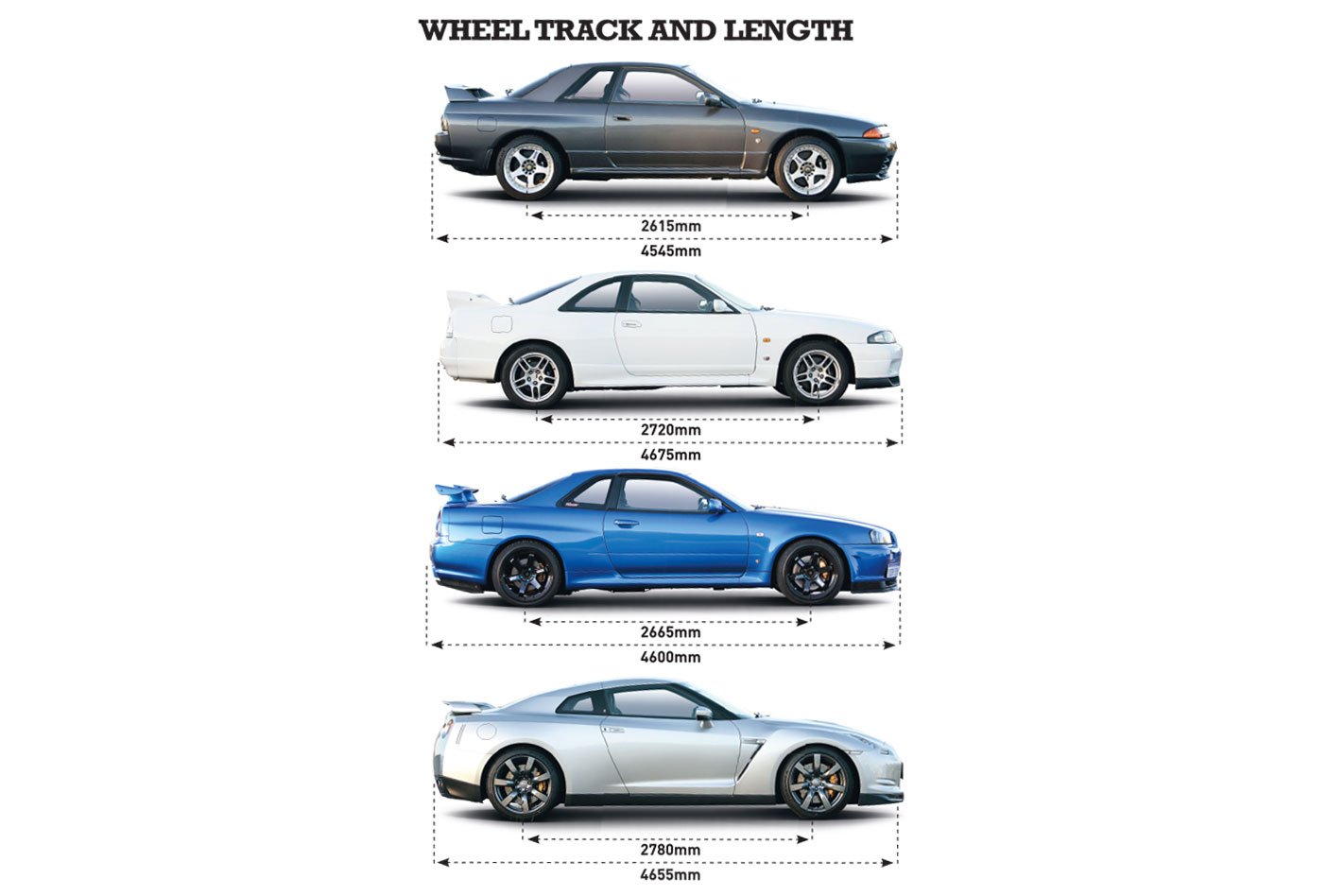
1994 R32 V-Spec II
The R32 GT-R is still considered the purest and most hardcore of the breed. It decimated touring-car racing globally, particularly at home in Japan and in Oz, and was outlawed shortly thereafter. Our test car is the last and perhaps finest of the R32 breed – a 1994 full-fruit V-Spec II, sporting factory Brembos, with juicy Nismo 17s in lieu of the original BBS wheels, super-wide 255mm Bridgestone RE010s, Nismo exhaust and instrumentation.
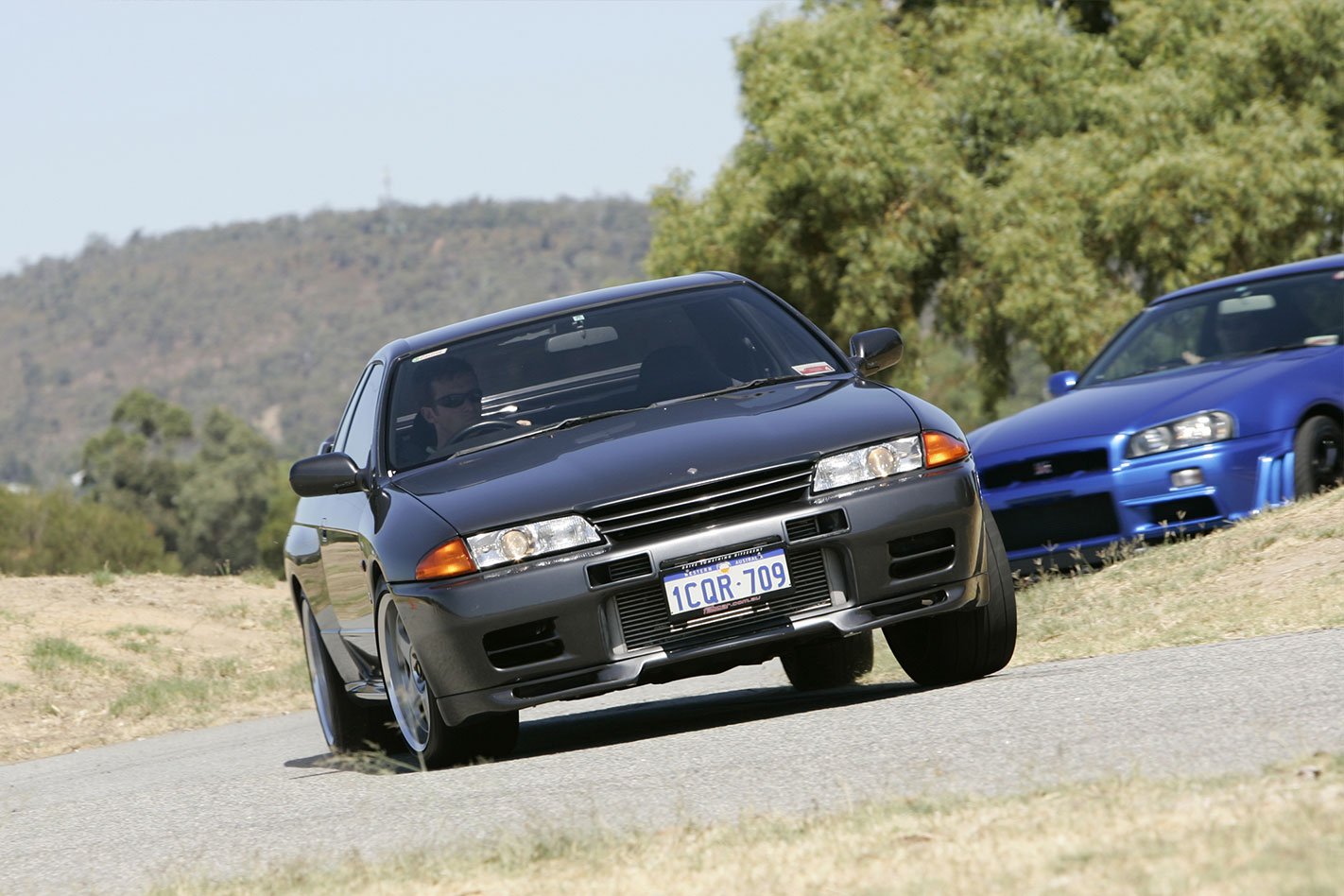
It’s the smallest and lightest here, yet the R32’s interior is reasonably spacious, if basic, with that now-retro mouse-fur trim Nissan once loved. The bolstered seats lack support, and grabbing the bus-sized tiller, you don’t exactly feel cocooned in comfort. Still, it all gels, and it’s simple and functional, and looks and feels pretty good considering Australia was cranking out EA to ED Falcons at the time and Billy Ray Cyrus was inspiring hairstyles. The odo says 36,000 kays but, to be honest, it feels longer in tooth; 15 years sitting around will do that.
Hitting the track, the original Godzilla’s steering feels light and direct, the five-speed shifts tightly (if a bit long in the throw) and the clutch is effortless.
But it’s the right foot that’s not generating much response. It’s clearly not an explosive car and needs concentrated and serious provocation to inspire the RB26DETT to soar above 5500rpm, up where momentum and keeping the turbos singing is crucial. There’s bugger-all torque down low, with an almost elastic delivery that never comes on boil with the ferocity you’d hoped for.
It’s brisk enough and lively enough, but start upping the pace and its limits are quickly exposed. While the R32 is light-footed and manoeuvrable in nature, it lacks the level of crispness and road-holding ability that you’d expect from Japan’s king-hitter, and has a strong tendency towards understeer. It requires plenty of pre-planning to place accurately, and all with your arms flailing around like a windmill. Despite this car’s wheel/tyre package, front-end bite falls off if you lean on the nose into a corner, significantly limiting entry pace.
The chassis also feels slightly unbalanced, as if the much-trumpeted RB26 and ATTESSA/ETS couple aren’t quite on intimate terms. There’s plenty of pitch and roll, and the R32 changes direction with little finesse or confidence, inconsistent at the rear at times, particularly under hard acceleration on exit. Needless to say, this example is an unpredictable beast.
The brakes lack bite, though it’s mainly a pedal feedback thing, or lack thereof, but once you give them a proper workout they pull things up well.
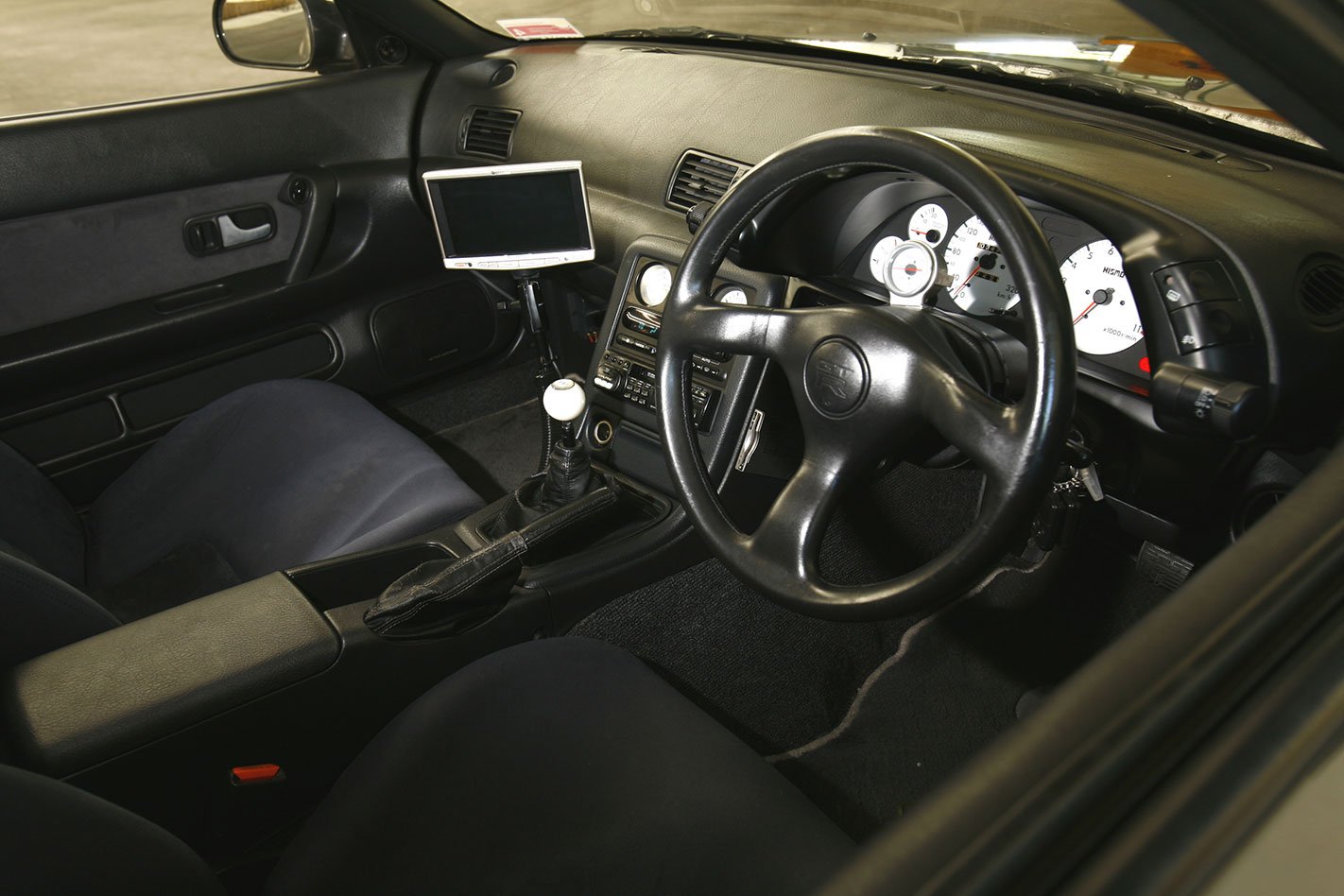
It’s true that you need to give old GT-Rs their legs, and maybe the course’s tight layout is hampering its inner God. Around our test track, it clocked a best of 52.27sec; slowest of the lot by over a full second. On an open-road, where you can rev it and let it carry more speed, the R32 might be happier and more in its element. Past Targa results over the last two decades reinforce this.
The R32 was a big tech shift and the start of a serious performance era. But I exited the car a bit confused. Glimpses of greatness were there and it’s obviously a cut above the Liberty RS Turbos and Galant VR-4s of its era. But you’d have to be wearing some pretty large blinkers and rose-coloured glasses to believe that the R32 is the all-time greatest, and that the world hasn’t moved on.
Original God
Launched in May 1989, the R32 GT-R was a wider-tracked version of the regular Skyline coupe, with pumped front and rear guards, an aluminium bonnet, and a new bodykit to aid cooling and improve down force. It also scored race-oriented seats and wheel, plus gauges for oil temp, AWD torque bias and turbo boost pressure.
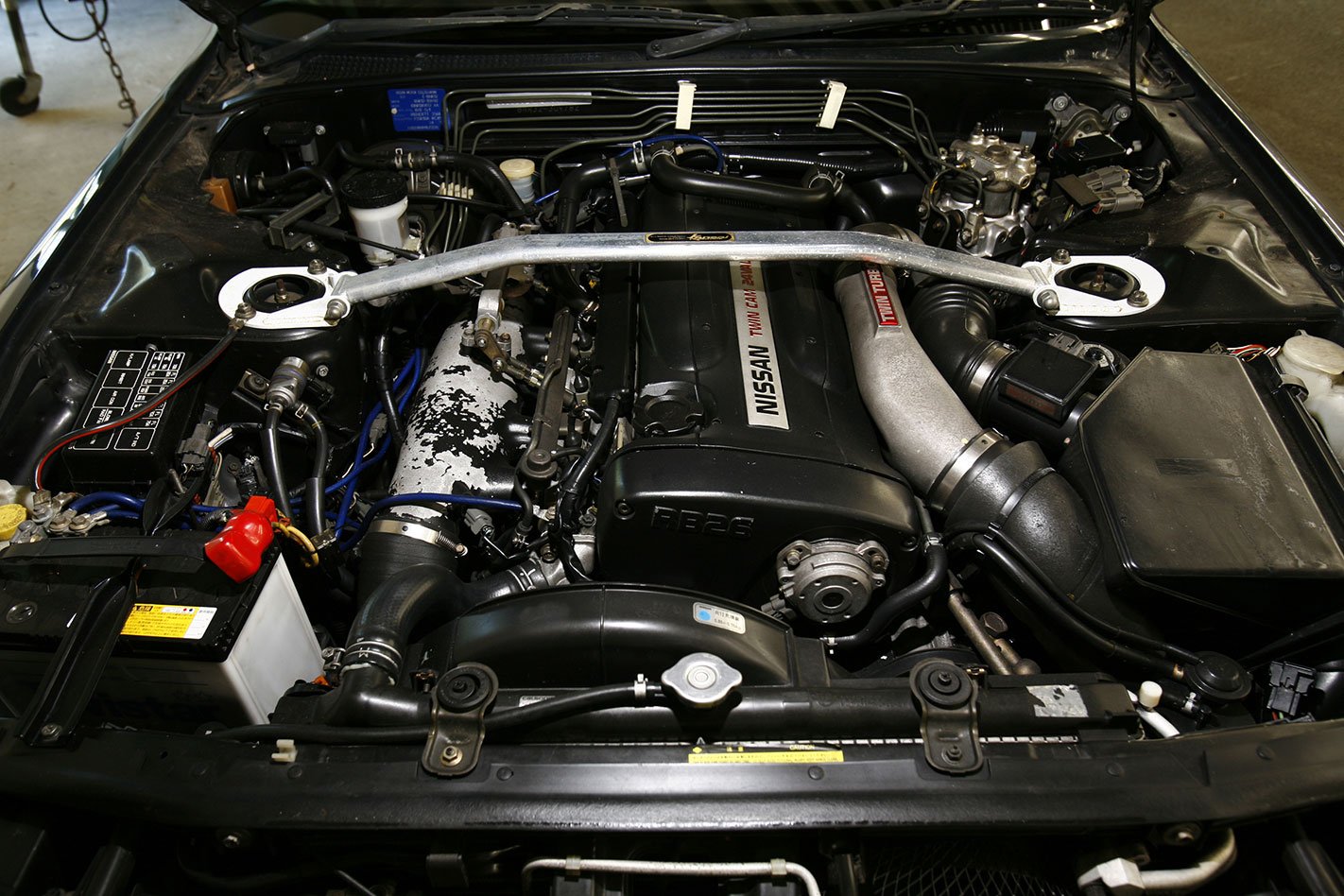
The 206kW twin-turbo RB26DETT six was mated to a five-speed gearbox and computer-controlled ATTESSA-ETS all-wheel-drive and HICAS four-wheel-steering systems. While essentially a rear-wheel-drive car, up 50 percent of engine torque can transfer to the front wheels when required; the hydraulically activated system using the ABS sensors to detect rear-wheel slip.
The ‘Victory Specification’ V-Spec and V-Spec II editions arrived in February ’93 and 1994, both with Brembo calipers, tweaked ATTESSA-ETS systems and larger 17-inch BBS rims. A lightweight N1 was also offered. In total, Nissan sold 43,934 R32 GT-Rs between 1989 and December ’94, all in Japan bar one batch of 100 officially sent to Australia in 1991.
And it’s those 100 GT-Rs you have to thank for the current two-make V8 series. In ’91 alone, the R32 won 9 of 11 races, including seven ATCC rounds, Sandown and Bathurst. After ‘92, they banned it.
1997 R33 V-Spec
With the R32 hardly setting things on fire, it’s up to the R33 GT-R to step up to the plate. The larger R33 is considered the biggest and fattest of the breed, both softer in styling and lacking the R32’s race-bred kudos. The upshot, though, is that it’s immensely popular and potentially capable in its own right, and scored an updated ATTESSA/ETS Pro system in V-Spec trim (which adds torque splitting between the rear wheels). The odo says 109,000 kays, but it feels as fresh as the R32. Bar questionable Chinese rubber, she’s a stock R33 GT-R V-Spec.
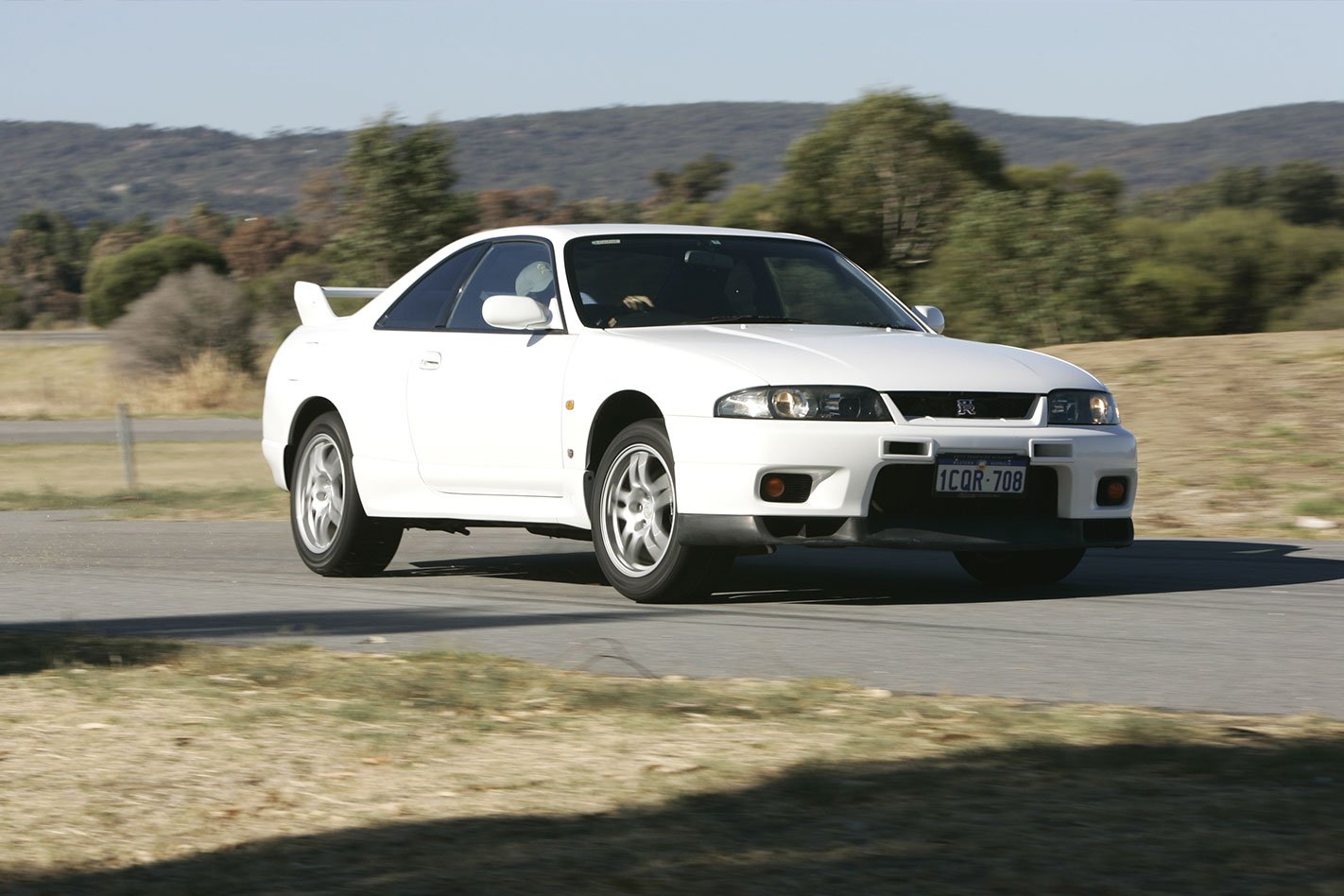
The R33’s cabin feels far fresher and more cohesive than its predecessor, reflecting more contemporary 90s styling: hard, dark plastic but very functional, if a bit lacklustre. The driving position is superior to the R32 and the seats are both tighter and comfier. As in its predecessor, the five-speed’s gearshift is precise and positive, and the clutch feels nice and progressive, if heavy.
Let’s be frank: our V-spec looks like a boat against the other three. It’s the least aggressive in its styling and more closely cut from the generic Skyline cloth. However, pull the anchor, attack the course and it only takes a few corners to discover it’s a more accomplished performer than the R32.
The RB26 copped little in the way changes over the prior model, but this one seems to breathe easier, with a little more energy everywhere between idle and redline. It still requires a heavy boot – and, admittedly, lots of swearing – to wind the six up, and it lacks the mid-range torque and throttle sharpness us 21st-century blokes have become accustomed to from newer turbo gear.
Like the R32, there’s plenty of pitch and roll, and yet the longer wheelbase makes it’s more predictable and less snappy. Steering, though, is no more or less precise in terms of feel and accuracy. You can position the car with greater confidence and less effort, but grip falls off quickly – it feels under-tyred – so you use more of the available real estate getting corner-entry right.
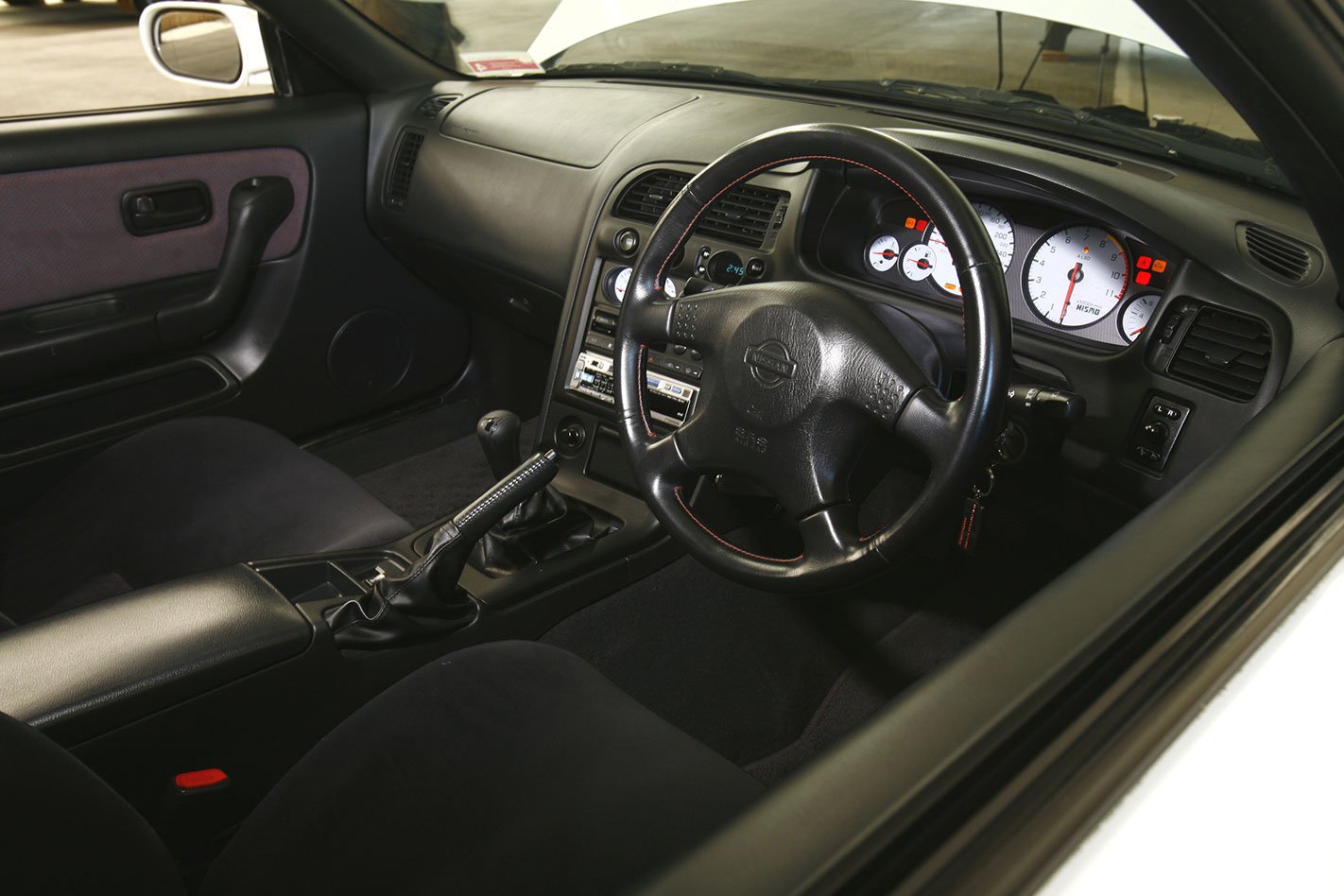
Turn-in and initial bite is a bit how’s-yer-father. Peg the throttle hard on corner exit and the rear always wants to wander, but without grace or focused power-down ability. However, it all functions more cohesively than the R32; despite the moving, pitching, and squirming, its chassis is consistent and predicable, and better balanced.
That said, it just ain’t that sharp, planted or responsive. The R33 also had the lowest stability under hard braking. Despite strong anchors, the chassis desperately tries to unglue the rear end on corner entry and you spend much of the corner manhandling it to keep it off the scenery.
It polarised the judges a bit (Pearce ranked it, Dupriez didn’t), but consensus is that the R33 is reasonably impressive, if far from awe-inspiring. It’s a decently balanced jigger yearning for greater chassis control and more stonk. Still, it’s a superior car to the R32 in feel, dynamics and performance, and proved it against the stopwatch. Call it a theatric yet reasonably brisk 51.12sec. You could feel Godzilla was in there somewhere…dozing.
Second Coming
The larger R33-generation Skyline GT-R (1995-1998) was offered in both base and V-Spec variants. The mechanical layout differed only slightly from that of the R32, with minor revisions in the five-speed gearbox and engine oil pump (for reliability). Brembo brakes and 17-inch alloy wheels are standard, while the V-Spec added improvements such as lower and stiffer suspension, and the ATTESSA-ETS Pro all-paw system (with individual rear-wheel torque control).
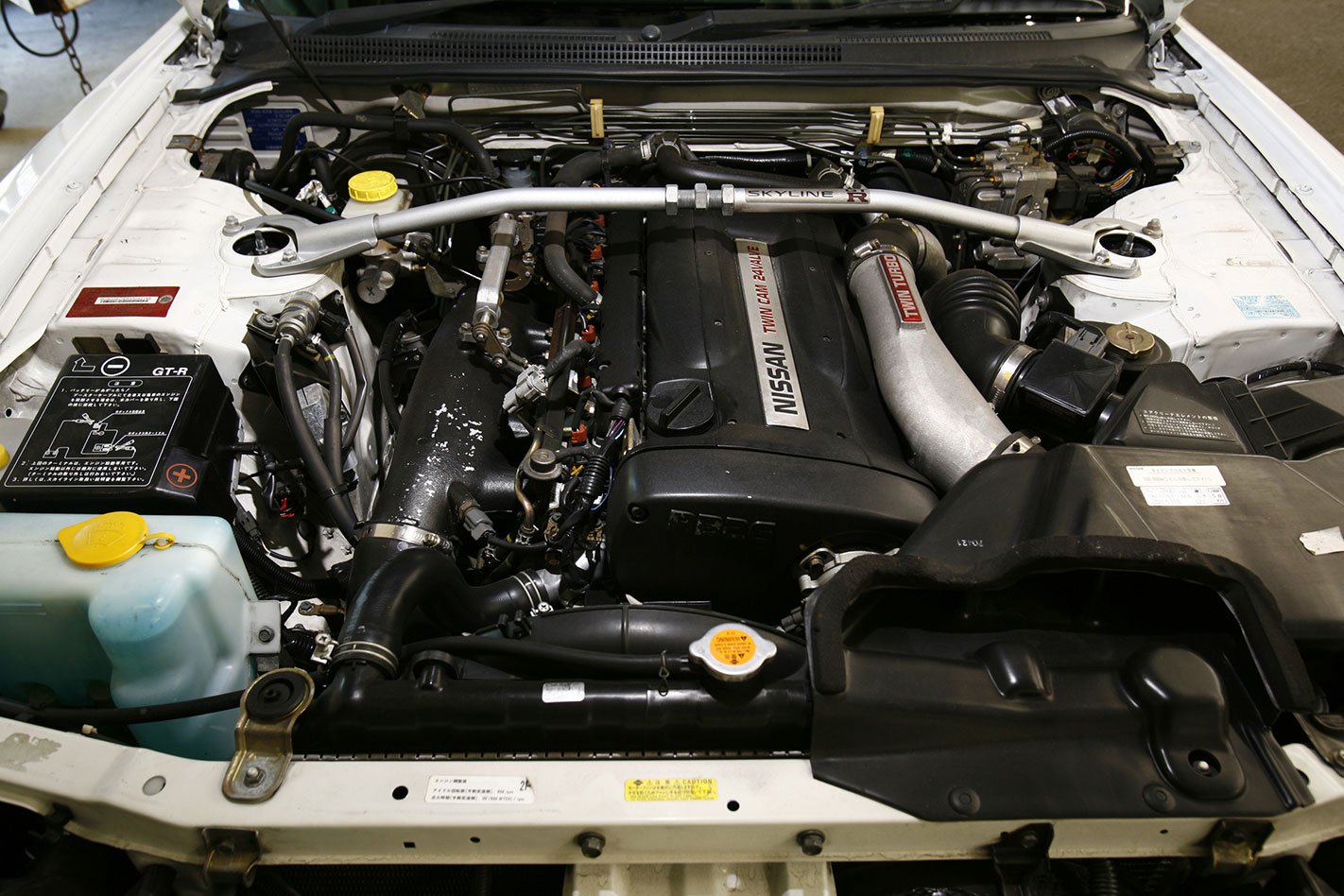
Performance was still outstanding despite the R33 GT-R weighing in a full 100kg more than the R32. Nissan claimed that the V-Spec lapped the Nordschleife circuit in under eight minutes in the hands of Dirk Schoysmans (albeit with the 180km/h speed limiter removed).
The Japan-only R33 GT-R sold in far smaller volumes than the R32, with sales totalling a mere 16,522 – 40 percent of which were V-Spec models (‘V’ variants account for just five percent of R32s).
2000 R34 V-Spec
Right here the story takes a twist. Y’see, lap times were cut late in the day, oldest to newest. Up to that point we’d spent hours playing musical chairs with the four, collecting our impressions and doing photography. And Blind Freddie could see that the R35 was not so much beating the old stuff for pace, it was butchering them.
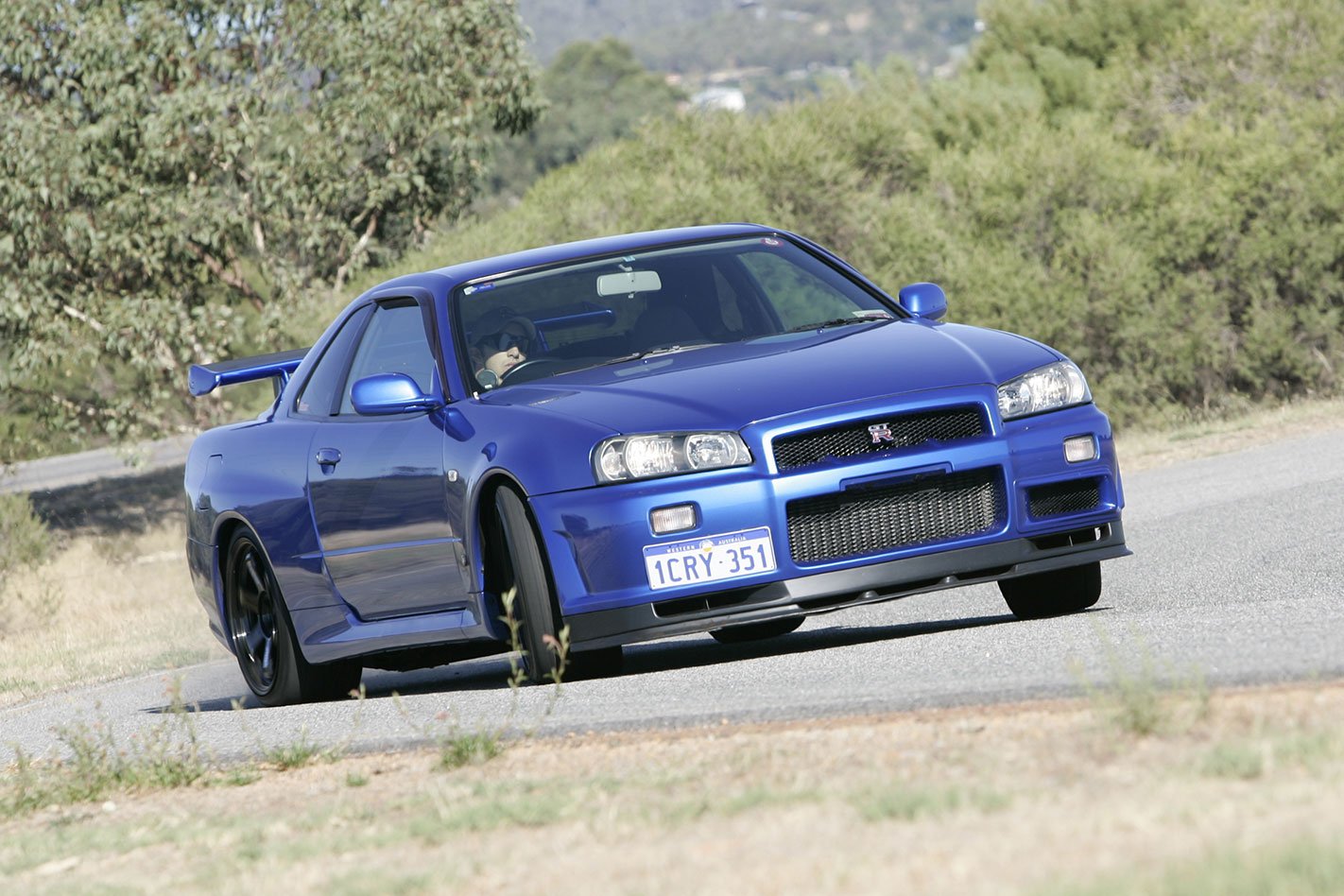
Decision time. We have two R34s. Would we use the mint, limited-run R34 V-Spec Nur or the blue R34 V-Spec enhanced with stiffer Bilstein coil-overs and huge Rays TE37 rims shod with 265mm track-savvy rubber? To give the old girls a fighting chance on our ‘handling course’, we chose the latter.
The newest, freshest and priciest, the R34 should be the best of the early GT-Rs. The first impression from inside is a progression from understated function to a high-tech gadget perfect for today’s Attention Deficit Disorder (or whatever the PC term is nowadays). The telemetry-style dash screen (displaying lap time, g-meters, temps and pressures gauges) dominates the cabin. And like its predecessors, there are no driver adjustable chassis smarts. It all works, with the best seats and tiller, the best driving position. The manual also gets an extra cog and, like the steering and clutch, feels crisp and mechanical. It’s wider than the R33, and roomier than the R35, but feels intimate and hardly porky.
Out on our course, the R34 instantly pulls harder everywhere and feels the most responsive, by far. Name the situation and it’s shining. Turn-in and front-end grip is sharp and consistent, and for the first time I’m not feeling the car pitching or rolling on entry. Sure, the coil-overs and rubber are doing no harm, but it’s more than that: this thing is much better balanced, especially on corner exits. The ATTESSA/ETS Pro and turbo six are well in sync; you squeeze the throttle, the bum cocks out a few degrees and there’s perfect, hard-pinning oversteer.
Despite the punchiness and grip, the chassis squirms and the torque transfer below is less than seamless. Steering is nicely sharp (though not quite Evo-like in its accuracy), it’s easy to place and adjust, and is surprisingly brisk on direction changes. You can attack harder in this than the R32 or R33.
The R34 is the perkiest, up to a point, but there’s no denying its RB26 roots. The linear and elastic torque and power still applies and it needs a wind up, though it’s plenty tractable and urgent.
Of the third-gen stuff, it stops with the least fuss, making the spongy pedal of the R32 a distant memory. The blue stunner is the first car with real balance, with more seat-of-the-pants feedback that yields fewer nasty surprises.
The R34 restores my faith in Skyline GT-Rs. It’s the best thus far, and yet in some ways it doesn’t go far enough. Its 49.79sec lap, just 1.3sec quicker than R33, wasn’t the quantum leap we expected.
Last In Line
The R34 Skyline GT-R (1999-2002) offered numerous improvements including a new close-ratio Getrag six-speed manual gearbox, 18-inch wheels, and its slightly shorter (yet broader) body and bolder styling addresses criticism that the R33 model was too bulky.

New is the 5.8-inch, dash-integrated LCD display, providing real-time information of engine (injector duty cycle, throttle position, etc) and ATTESSA-PRO vitals. Nissan still claimed 206kW, although turbo boost pressure could now be varied between 0.7bar and 1.0bar.
A softer, leather trimmed M-Spec variant is offered alongside the popular V-Spec I and II models, which are equipped with front and (carbonfibre) rear diffusers, an adjustable rear wing, and enhanced functionality for the dash-mounted display. A limited run of lightweight N1s were released, as were Nur variants to commemorate R34’s 24-hour production car enduro racing at Nurburgring.
In 2004, factory motorsport arm Nismo ‘remanufactured’ used R34s to create 20 monstrous 368kW 2.8-litre Z-tune models.
2008 R35 Black Edition
Lucky last is the R35. The whole afternoon was a build-up of anticipation, yet we don’t have to wait for the stopwatch for the answer to The Big Question. Run one, the black beast (sans launch control) blasts off, zips right past the roundabout, jinks through the 90-degree left-hander and just simply unleashes. In this exact instant, the spectators on the grass hill let out a collective gasp that starts with “F” and ends with “aaaark!” Soon it screams to a furious halt in the final braking area, I’m not even game to ask the time, my heart sinking for the old girls. And their reputations.
“What’d it do?” The walkie-talkie crackles and pauses. “Erm … 46.18sec.”

Bloody heck! That’s 3.6 quicker than the R34, five brisker than R33, and over six seconds faster than the original Godzilla. And it’s a very short track.
The biggest and heaviest car here (by 210kg!), the tight course should’ve handicapped the R35. And yet it devours the confines effortlessly.
It feels fuss-free, too: the best (if heaviest) steering, fantastic seats, clear instrumentation and the feeling that you’re in something truly special. Sure, the tech factor’s gone off the scale. But while you can ignore the gizmo fetishes, you can’t ignore the tangible advantages from switchable traction control, suspension and transmission smarts.
Set to ‘On’, ‘R’ and ‘R’ respectively, turn-in is razor sharp, with little sign of any push until things start getting way hot or ambitious. And even with blinding torque available mid-corner, the new four-wheel-drive system just channels it to earth without bother and with barely any attitude change to the chassis. Corner-exit grip and power-down is astonishing. For the first time today there’s a beast that simply has more on tap – power, handling and braking – than you really need, everywhere.
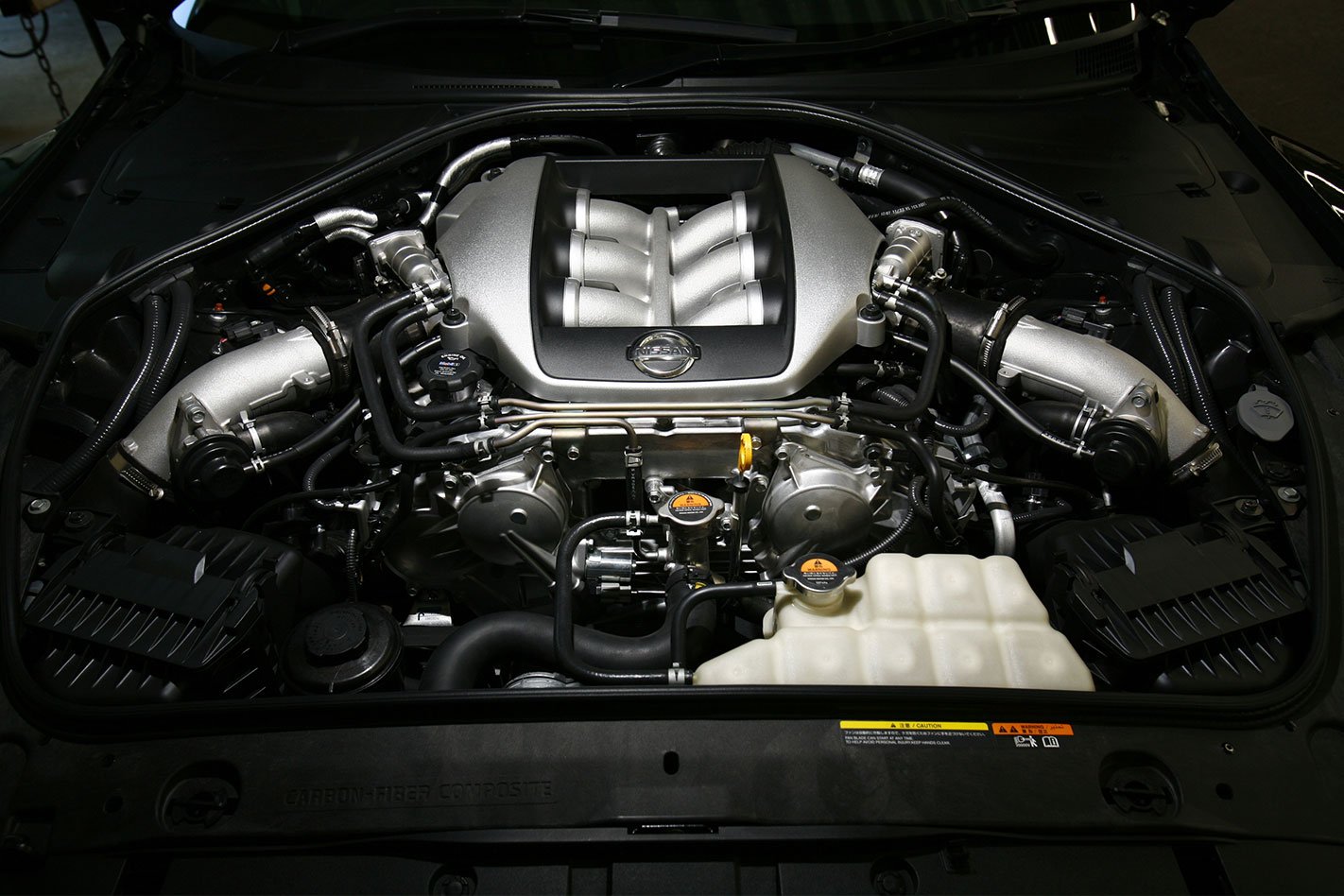
The power is not only heady and dizzying, but with the gearbox (in manual Race mode) that seamlessly makes use of every Newton. Yet, as this course is bereft of exploitable straight bits (see map) all the grunt gains are being tapped in the corners and under brakes. Even after the R34 you need to reprogram your brain as to just how deep and hard you can get on its anchors.
It sits so much flatter and firmer than the others, and body control is so much tighter, but it’s the R35’s willingness to change direction that defies physics. The car is a paradox: despite its size and weight it’s easily the most agile, most responsive, the grippiest, best-behaved and by far the most controllable and rewarding. At a pace where even the R34 is squirming around on its limits, the R35 just grips and goes at what feels like seven-tenths.
Gripes against its kindred rivals are pretty few and far between. It’s less playful at sane speeds – particularly against the R34 – because, well, it’s so freaking fast and composed. It also gets whiffy and tinks away after a hard punt. Hardly condemning criticism, eh? And, yes, it’s more expensive (duh) and hard to get hold of (double duh). We expected greatness, but we’re a bit stunned by the caning it gave the others on a course where it shouldn’t have.
The Fab Four
A massive thanks goes out to Steve Jones, Frank Bempasciuto Jr. and Snr., and all of the lads from Perth specialist importer, Fabcar, who generously supplied six GT-Rs for the shootout and graciously let us have our way with them.
The Bempasciutos have been in the import business for 35 years now, starting with Italian exotics in 1971, later moving into the 90s Japanese high-performance gear in which they now specialises.
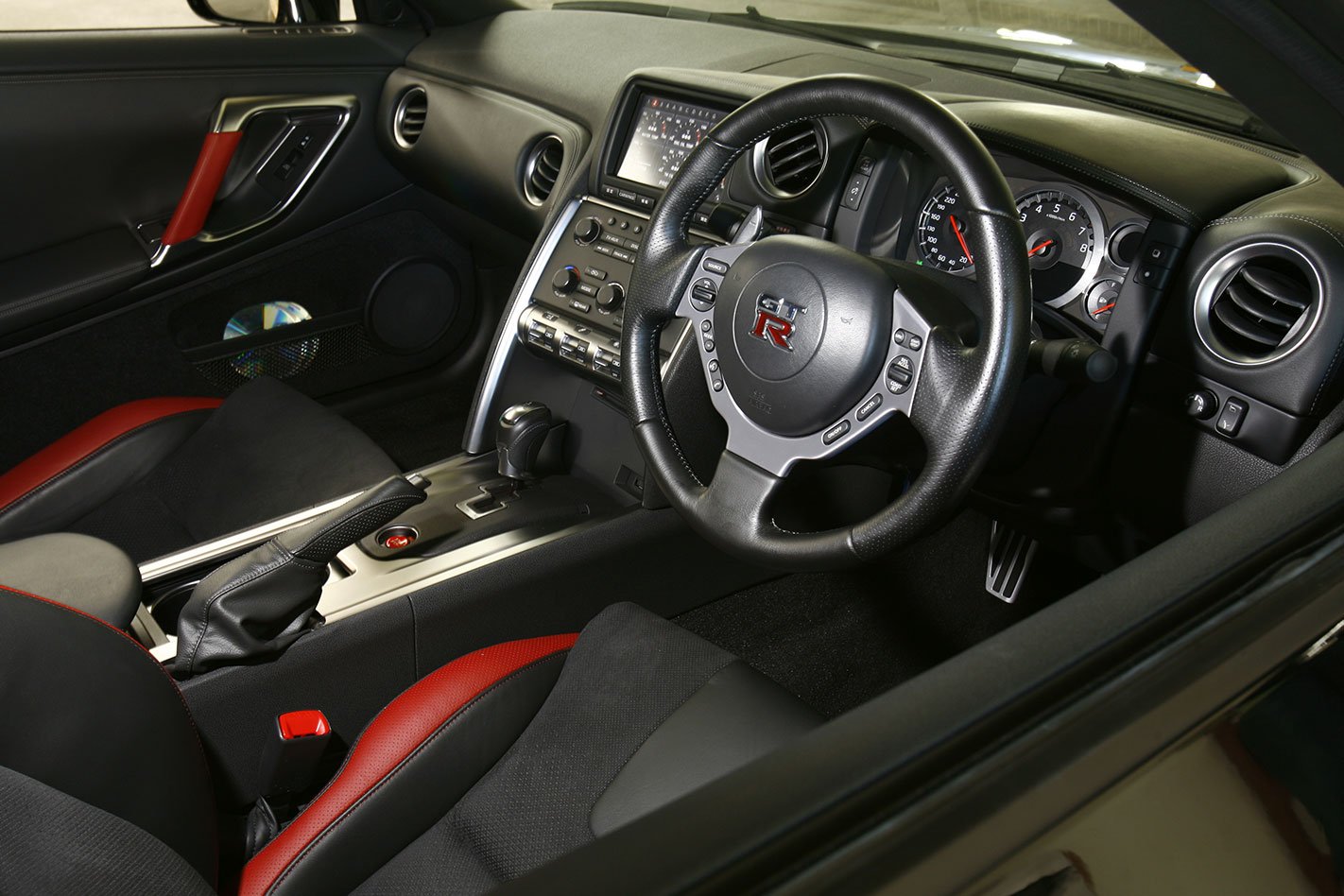
The company has imported and sold three R35s to date, all Black Editions, and all intended for race/rally use. Price is on application, mainly due to limited availability of cars out of Japan, but don’t expect any change from about $150,000 for a race-only R35.
Owned by Jones, our black test car will become Fabcar Racing 2008’s entrant in this years Targa West, and the crew is a long-time supporter of its local motorsport scene.
Conclusion
Regardless of age, condition and the degree of (light) modification, the older Skyline GT-Rs didn’t present any surprises in their pecking order, although we did expect the R32 to push the R33 a bit harder around the tight course. Their RB26DETT engines’ performance didn’t progress in leaps and bounds, and all felt a bit elastic in delivery and in need of more tractability. The new V6, though, was a standout, light years ahead for power, torque and response, which combined pays dividends on both track and road.
In truth, the degree to which R35 was quicker and more capable than its predecessors doesn’t come as a big surprise. We’re talking two decades of evolution here.
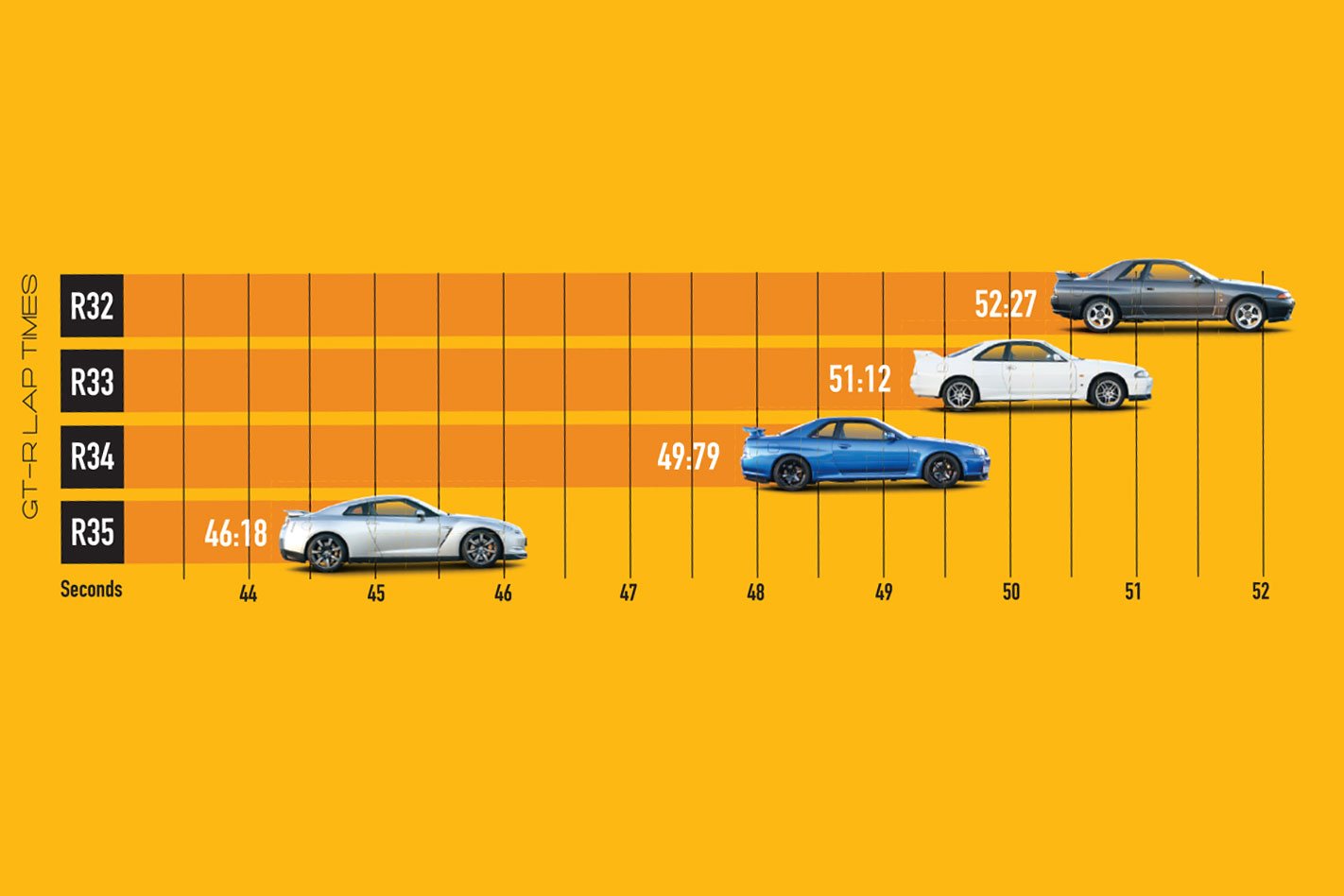
That doesn’t change the fact that if you were to extrapolate R35’s eight- to ten-percent quicker pace around a larger circuit – say, Eastern Creek – it’d pummel the R34 to the tune of around 10 seconds per lap! And about 18 seconds quicker than the R32 (if you lifted R35’s speed limiter).
Yes, the R34 proved that a few modification goes a long way with the Skylines. And with a truckload of cash you could build a military-spec Skyline to match R35’s immense pace and agility. But match New Boy’s estimated $150K ask and a wieldy, hand grenade-spec racer wouldn’t be nearly as useable, flexible or liveable in the real world as the stock R35 GT-R.
There is kinship between generations. The R32, R33 and R34 are all very Japanese; the R35 even more so. All deserve to be celebrated for their overt technology and imposing lines. And would we happily spend our own money on any of them? Sure.
But there’s an alternative and rather sobering reality. Nissan claims a direct lineage from old to new. And, with all respect to the old stuff and their consummate legend, the R35 is technically and dynamically unrelated. Similarities end with the tail lights and badge.
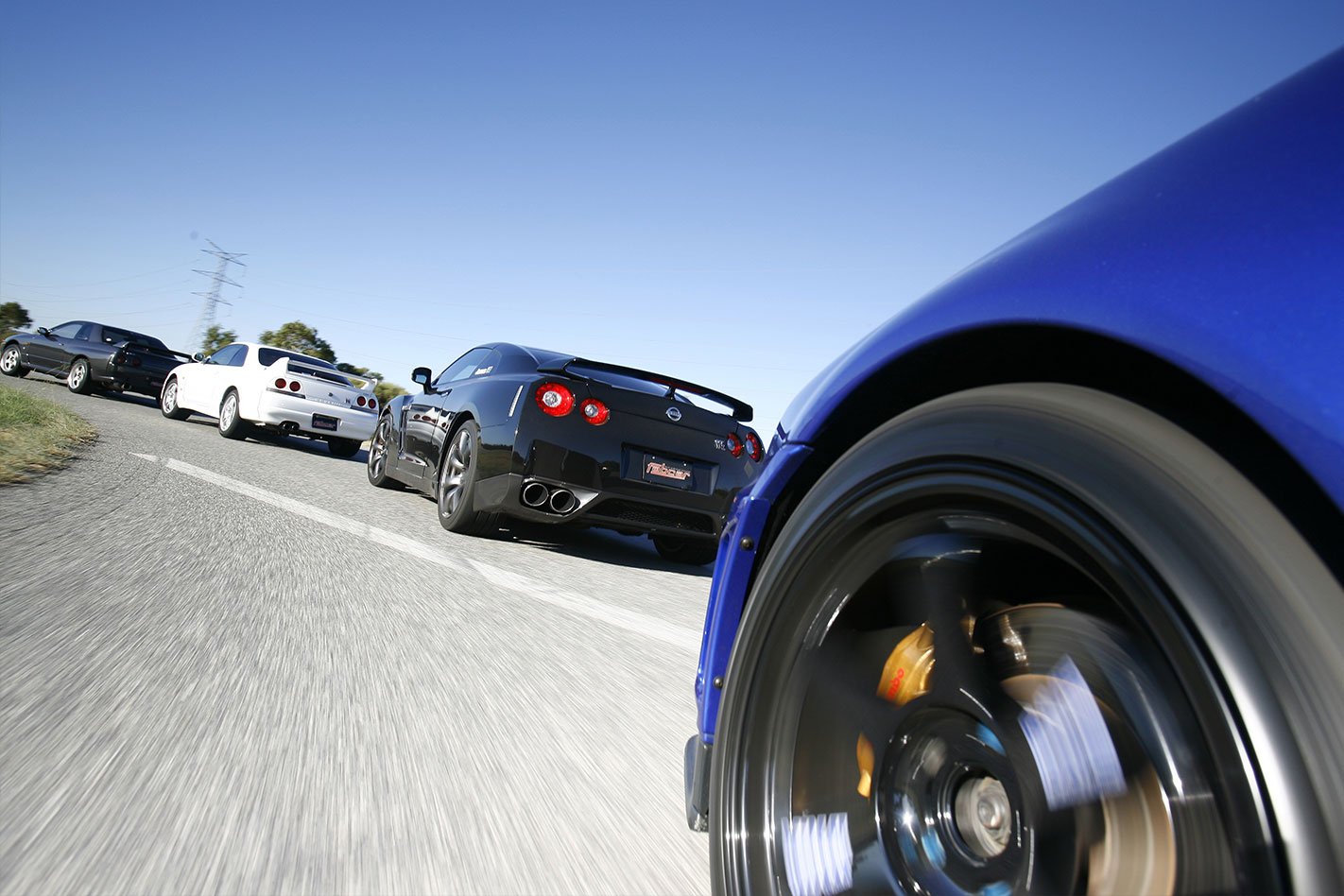
The R35 is not just a big step forward, it’s a pole vault. It doesn’t feel a generation improved, it feels more like two or three. The new car not only lives up to the legend, it surpasses it to a point where Nissan could’ve called it something else.
Nostalgia buffs who mourn the loss of the Skyline name and the straight-six might reject the R35 as somehow being unfaithful. But the newie ain’t looking back, in sympathy.
Nissan Skyline GT-R specs
| u00a0 | 1994 R32 GT-R V-Spec II | 1997 R33 GT-R V-Spec | 2000 R34 GT-R V-Spec | 2008 R35 GT-R black edition |
|---|---|---|---|---|
| BODY | 2-door, 4-seat coupe | 2-door, 4-seat coupe | 2-door, 4-seat coupe | 2-door, 4-seat coupe |
| DRIVE | all-wheel; 5-speed manual | all-wheel; 5-speed manual | all-wheel; 6-speed manual | all-wheel; 6-speed dual-clutch |
| ENGINE | 2568cc inline-6cyl, DOHC, 24v, twin-turbocharged; alloy head/iron block | 2568cc inline-6cyl, DOHC, 24v, twin-turbocharged; alloy head/iron block | 2568cc inline-6cyl, DOHC, 24v, twin-turbocharged; alloy head/iron block | 3799cc 60-degree V6, DOHC, 24v, twin turbocharged; alloy head/alloy block |
| BORE/STROKE | 86.0 x 73.8mm | 86.0 x 73.8mm | 86.0 x 73.8mm | 95.5 x 88.4mm |
| COMPRESSION | 8.5:1 | 8.5:1 | 8.5:1 | 9.0:1 |
| POWER | 206kW @ 6800rpm | 206kW @ 6800rpm | 206kW @ 6800rpm | 353kW @ 6400rpm |
| TORQUE | 353Nm @ 4400rpm | 367Nm @ 4000rpm | 400Nm @ 4400rpm | 588Nm @ 3200-5200rpm |
| FUEL/TANK | 98 octane/72 litres | 98 octane/65 litres | 98 octane/65 litres | 98 octane/71 litres |
| KERB WEIGHT | 1430kg | 1530kg | 1540kg | 1750kg |
| POWER-TO-WEIGHT | 144kW/tonne | 135kW/tonne | 134kW/tonne | 202kW/tonne |
| SUSPENSION | struts, A-arms, anti-roll bar (f); multi-links, coil springs, anti-roll bar (r) | struts, A-arms, anti-roll bar (f); multi-links, coil springs, anti-roll bar (r) | coil-over struts, A-arms, anti-roll bar (f); multi-links, coil springs, anti-roll bar (r) | double A-arms, coil springs, anti-roll bar (f); multi-links, coil springs, anti-roll bar (r) |
| STEERING | power rack and pinion (f), hydraulic (r) | power rack and pinion (f), hydraulic (r) | power rack and pinion (f), hydraulic (r) | power rack and pinion (f) |
| BRAKES | 324mm ventilated discs, four-piston calipers (f); 300mm ventilated discs, two-piston calipers (r), ABS | 324mm ventilated discs, four-piston calipers (f); 300mm ventilated discs, two-piston calipers (r), ABS | 324mm ventilated discs, four-piston calipers (f); 300mm ventilated discs, two-piston calipers (r), ABS | 380mm ventilated discs, six-piston calipers (f); 380mm ventilated discs, four-piston calipers (r), ABS |
| TYRES | Bridgestone RE01 | Roadstone N3000 | Toyo Proxes T1R | Bridgestone Potenza RE070R |
| WHEELS | 255/40ZR17 (f&r) | 245/45R17 (f&r) | 265/35ZR18 (f&r) | 255/40ZRF20 (f), 285/35ZRF20 (r) |
| PRICE | $80,000+ | $100,000+u00a0 | $200,000+ | $150,000 (est, as tested) |
| LIKE | Visionary tech, tons of cred, cheap as chips, massive tuning potential | Great balance, roomy, affordable, huge tuning potential | Sharp chassis, excellent steering and brakes, responsive AWD | Weapons-grade all-round performance and dynamics |
| DISLIKE | Power, handling and braking less then legendary, feels dated | Bland styling, poor grip, soft chassis, needs revs, lacks torque | Import-only buying prospect. Needs a wind-up, firm ride | No Oz-spec yet, no rego, huge bucks for a weekend racer |


